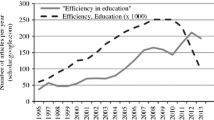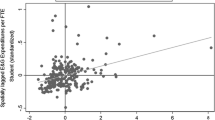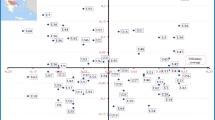Abstract
This paper aims at appraising the cost efficiency and technology of institutions of higher technological and vocational education. Differing from conventional literature, it considers the potential influence of inherent discrepancies in output quality and characteristics of school systems for institutes of technology (ITs) and universities of technology (UTs). Moreover, to meet the purpose, this study conducted a seemingly unrelated regression—metafrontier cost-function model framework, which is extended from the classical metafrontier production function model and tailor-made for the theme. The econometric analysis utilizes a set of micro-level panel data that spans 6 years inclusive of 60 ITs and 29 UTs in Taiwan. The empirical results clearly reveal that the UTs own a superior cost-exploiting and -controlling capability for the operation of educational institutions to ITs’, given the quality dimension. Further, the estimated results of public and private schools for the UTs indeed do not vary by a wide margin, but this is not the case for the ITs. The statistical figures imply that the UTs are significantly more efficient than the ITs.






Similar content being viewed by others
Notes
The phrase ‘blue ocean’ originated from a popular book written by W.C. Kim and R. Mauborgne published by the Harvard Business School Press in 2005 with ISBN 1591396190. The book stressed that the lasting success of a business comes not from battling competitors, but from creating ‘blue oceans’: untapped new market spaces ripe for growth. Such strategic moves—which the authors called ‘value innovation’—create powerful leaps in value that often render rivals obsolete for more than a decade. Relatively, the conventional cut-throat competition results in nothing but a bloody red ocean of rivals fighting over a shrinking profit pool. Accordingly, the ‘blue ocean’ could be briefly defined as a strategy of ‘winning by not competing for a lasting success’.
To economize on the paper length, the related literature is tabulated. Please refer to Table 8 in the appendix for details.
The teaching cost includes administrative expenses, teaching, research and counselling expenses, student allowances and scholarship expenses, extended education and other teaching expenses, cooperative education expenses, other expenses, the board of directors’expenses, and financial expenses.
Tao and Yuan (2005) analysed the optimal operating scale for the public elementary schools in Taipei county of Taiwan under the consideration of transportation costs. In the study, four input prices are constructed with the average concept, of which the teaching price is measured as the teaching cost divided by the number of classes. Nonetheless, in this paper, considering the characteristic of diversified educational systems, to use the number of classes as the denominator of the teaching price measure does not seem so appropriate for HTVEIs. We thus adopt the number of students as a substitution.
The number of teachers indicates a total of full-time and adjunct teachers. To avoid an unreasonable count of the number of adjunct teachers, we refer to the ‘operating stipulation of upgrading IT to UT’, where a full-time teacher indicates a qualified full-time lecturer and above, while four adjunct teachers are counted as one full-time teacher.
In 2001–2003, UTs’ graduates were mainly from graduate school and university, ITs’ graduates were mainly from university and junior college, while junior college graduates were from junior college.
Referring to the ‘operating stipulation of upgrading IT to UT’, the number of students should be counted on the basis of the status of the student; the graduate student should be weighted by two in the count.
The equivalent number of teachers represents a total of full-time and adjunct teachers. Nonetheless, to avoid an unreasonable count of the number of adjunct teachers, we refer to the ‘operating stipulation of upgrading ITs to UTs’: a full-time teacher indicates a qualified full-time lecturer and above, while four adjunct teachers are counted as one full-time teacher.
The reason we treated the certificate ratio as a measure of quality is because for the HTVEIs, practical applied technology is just the core of educational administration and students’ study. In Taiwan, the job market has entered into an era of professional certificates and qualifications, and obtaining certificates and qualifications has already served as the basic threshold to get into professional jobs. Although some might feel that certificates or qualifications cannot represent professionalism, they at least denote a fundamental recognition that a student should be equipped for entering a professional practical domain; in the meantime, the enterprises in Taiwan usually also request their staff to obtain certificates. Hence, to obtain the certificates and qualifications is not a question about the willingness of students, but about necessity. The certificate ratio is naturally regarded as a dimension of measuring or representing students’ study achievement.
The objective of standardization is to satisfy the homogeneity condition of the factor price of the cost function. We use the labour price as the numéraire. The standardized total cost is ‘total cost/labour price’. The standardized factor input price is ‘other factor input price/labour price’.
Zellner (1962) proved the consistency and efficiency of SUR estimation.
Also refers to Kumbhakar and Lovell (2000).
Referring to Kumbhakar and Lovell (2000), it is adjusted as: \( \hat{\alpha }_{0}^{k} = [\alpha_{0}^{k} - E(\hat{u}_{it}^{k} )] + (\sqrt {2/\pi } )\hat{\sigma }_{u}^{k} \).
In Battese et al. (2004), the parameters for the production function are estimated with MLE first and then used to calculate technical efficiency. While applying this to the cost function, the value of cost efficiency would be larger than unity. Thus, it is necessary to compute the reciprocal of the estimation.
The figures that map the distribution of HEIs’ metafrontier cost-efficiency scores obtained by LP and QP estimations, respectively, are provided in Fig. 2 in the appendix for reference.
According to the concept interpretation of Fig. 1 above, the figure 0.9382 denotes that the institution faces a 6.18 % (i.e. 1−0.9382 = 0.0618) margin of cost inefficiency; that is, 6.18 % of the actual cost ought to be saved.
References
Ahn, T., Charnes, A., & Cooper, W. W. (1988). Some statistical and DEA evaluation of relative efficiencies of public and private institutions of higher learning. Socio-Economic Planning Sciences, 22(6), 259–269.
Assaf, A. (2008). Accounting for size in efficiency comparisons of airports. Journal of Air Transport Management, 15(5), 256–258.
Athanassopoulos, A. D., & Shale, E. (1997). Assessing the comparative efficiency of higher education institutions in the UK by means of data envelopment analysis. Education Economics, 5(2), 117–134.
Avkiran, N. K. (2001). Investigating technical and scale efficiency of Australian universities through data envelopment analysis. Socio-Economic Planning Sciences, 35(1), 57–80.
Battese, G. E., & Coelli, T. J. (1988). Prediction of firm-level technical efficiencies with a generalised frontier production function and panel data. Journal of Econometrics, 38(3), 387–399.
Battese, G. E., & Coelli, T. J. (1992). Frontier production functions, technical efficiency and panel data: With application to paddy farmers in India. Journal of Productivity Analysis, 3(1–2), 153–169.
Battese, G. E., & Rao, D. S. P. (2002). Technology gap, efficiency, and a stochastic metafrontier function. International Journal of Business and Economics, 1(2), 87–93.
Battese, G. E., Rao, D. S. P., & O’Donnell, C. J. (2004). A metafrontier production function for estimation of technical efficiencies and technology gaps for firms operating under different technologies. Journal of Productivity Analysis, 21(1), 91–103.
Binam, J. N., Gockowski, J., & Nkamleu, G. B. (2008). Technical efficiency and productivity potential of cocoa farmers in West African countries. The Developing Economies, 46(3), 242–263.
Boshrabadi, H. M., Villano, R., & Fleming, E. (2008). Technical efficiency and environmental-technological gaps in wheat production in Kerman Province of Iran. Agricultural Economics, 38(1), 67–76.
Boskin, M. J., & Lau, L. J. (1992). International and intertemporal comparison of productive efficiency: An application of the meta-production function approach to the Group-of-Five (G-5) countries. The Economic Studies Quarterly, 43(4), 298–312.
Cave, D. W., & Chirstensen, L. R. (1980). The relative efficiency of public and private firms in a competitive environment: the case of Canadian railroads. Journal of Political Economy, 88, 958–976.
Chakraborty, K., Biswas, B., & Lewis, W. C. (2001). Measurement of technical efficiency in public education: a stochastic and nonstochastic production function approach. Southern Economic Journal, 67(4), 889–905.
Chang, T. Y., Chung, P. H., & Hsu, S. S. (2012). Two-stage performance model for evaluating the managerial efficiency of higher education: application by the Taiwanese tourism and leisure department. Journal of Hospitality, Leisure, Sport and Tourism Education, 11, 168–177.
Chen, K. H., Huang, Y. J., & Yang, C. H. (2009). Analysis of regional productivity growth in China: A generalized metafrontier MPI approach. China Economic Review, 20(4), 777–792.
Chen, Z., & Song, S. (2008). Efficiency and technology gap in China’s agriculture: A regional meta-frontier analysis. China Economic Review, 19(2), 287–296.
Cherchye, L., De Witte, K., Ooghe, E., & Nicaise, I. (2010). Efficiency and equity in private and public education: A nonparametric comparison. European Journal of Operational Research, 202, 563–573.
Cho, T. Y., Lin, S. H., Chen, M. C., & Huang, M. H. (2009). The study on the economies of scale of higher education in Taiwan. Educational Policy Forum, 12(1), 41–69.
Cohn, E., Rhine, S. L. W., & Santos, M. C. (1989). Institutions of higher education as multi-product firms: Economies of scale and scope. The Review of Economics and Statistics, 71(2), 284–290.
Colbert, A., Levary, R. R., & Shaner, M. C. (2000). Determining the relative efficiency of MBA programs using DEA. European Journal of Operational Research, 125(3), 656–669.
Daghbashyan, Z. (2011). The economic efficiency of Swedish higher education institutions. CESIS Electronic Working Paper Series, Paper No. 245.
De Groot, H., McMahon, W. W., & Volkwin, J. F. (1991). The cost structure of American research universities. The Review of Economics and Statistics, 73(3), 424–431.
De Witte, K., & Marques, R. C. (2009). Capturing the environment: A metafrontier approach to the drinking water sector. International Transactions in Operational Research, 16(2), 257–271.
Fu, T. T., Huang, C. J., & Tien, F. F. (2008). University cost structure in Taiwan. Contemporary Economic Policy, 26(4), 651–662.
Gibbons, S., & Vignoles, A. (2012). Geography, choice and participation in higher education in England. Regional Science and Urban Economics, 42, 98–113.
Glass, J. C., McCallion, G., McKillop, D. G., Rasaratnam, S., & Stringer, K. S. (2006). Implication of variant efficiency measures for policy evaluations in UK higher education. Socio-Economic Planning Sciences, 40, 119–142.
Glass, J. C., Mckillop, D. G., & Hyndman, N. S. (1995). The achievement of scale efficiency in UK universities: A multiple-input multiple-output analysis. Education Economics, 3(3), 249–263.
Gunarantne, L.H.P., & Leung, P.S. (2001). Asian black tiger shrimp industry: A productivity analysis. In Economics and management of shrimp and carp farming in Asia: A collection of research papers based on the ADB/NACA farm performance survey (Chap. 5, p. 240). Bangkok: Network of Aquaculture Centers in Asia-Pacific (NACA).
Hashimoto, K., & Cohn, E. (1997). Economies of scale and scope in Japanese private universities. Education Economics, 5(2), 107–115.
Hayami, Y. (1969). Sources of agricultural productivity gap among selected countries. American Journal of Agricultural Economics, 51(3), 564–575.
Hayami, Y., & Ruttan, V. W. (1970). Agricultural productivity differences among countries. The American Economic Review, 60(5), 895–911.
Higgins, J. C. (1989). Performance measurement in universities. European Journal of Operational Research, 38, 358–368.
Hilton, W. R. (1999). Managerial accounting (4th ed.). New York: McGraw-Hill.
Hou, L. L., Li, F. L., & Min, W. F. (2009). Multi-product total cost functions for higher education: The case of Chinese research universities. Economics of Education Review, 28(4), 505–511.
Huang, T. H., Chiang, L. C., & Chen, K. C. (2009). An application of the meta-frontier cost function to the study of bank efficiencies and technology gaps in 16 European countries. Management Review, 32(1), 15–23.
Johnes, G. (1997). Cost and industrial structure in contemporary British higher education. The Economic Journal, 107, 727–737.
Johnes, G., & Johnes, J. (1993). Measuring the research performance of UK economics departments: an application of data envelopment analysis. Oxford Economic Papers, 45, 332–347.
Kang, L. K., & Hsu, S. F. (2004). A research on the establishment of evaluation indicators for managerial efficiency in universities and colleges of technology. Educational Policy Forum, 7(1), 59–82.
Kempkes, G., & Pohl, C. (2008). Do institutions matter for university cost efficiency? Evidence from Germany. CESifo Economics Studies, 54, 177–203.
Kim, J. L., & Lau, L. J. (1994). The sources of economic growth of the East Asian newly industrialized countries. Journal of the Japanese and International Economies, 8, 235–271.
Koshal, R. K., & Koshal, M. (1995). Quality and economies of scale in higher education. Applied Economics, 27(8), 773–778.
Koshal, R. K., & Koshal, M. (1999). Economies of scale and scope in higher education: A case of comprehensive universities. Economics of Education Review, 18(2), 269–277.
Koshal, R. K., Koshal, M., & Gutpa, A. (2001). Multi-product total cost function for higher education: A case of bible colleges. Economics of Education Review, 20(3), 297–303.
Kumbhakar, S. C., & Lovell, C. A. K. (2000). Stochastic frontier analysis. New York: Cambridge University Press.
Kuo, J.H. (2000). Performance evaluation of multiple production process: measuring the comparative efficiency of higher education institutions in Taiwan. Graduate Institution of Accounting of National Taiwan University, Dissertation.
Kuo, J. S., & Ho, Y. C. (2008). The cost efficiency impact of the University Operation Fund on public universities in Taiwan. Economics of Education Review, 27(5), 603–612.
Lau, L. J., & Yotopoulos, P. A. (1989). The meta-production function approach to technological change in world agriculture. Journal of Development Economics, 31, 241–269.
Lenton, P. (2008). The cost structure of higher education in further education colleges in England. Economics of Education Review, 27(4), 471–482.
Lewis, D. R., & Dundar, H. (1995). Economies of scale and scope in Turkish universities. Education Economics, 3(2), 133–158.
Lindsay, A. W. (1982). Institutional performance in higher education: the efficiency dimension. Review of Educational Research, 52, 175–199.
Lu, Y. H., & Fu, T. T. (2007). Efficiency evaluation of polytechnic higher education institutions with considering output quality and institutional characteristics. Management Review, 26(2), 1–21.
Madden, G., Savage, S., & Kemp, S. (1997). Measuring public sector efficiency: A study of economics departments at Australian universities. Education Economics, 5(2), 153–168.
Mensah, Y. M., & Werner, R. (2003). Cost efficiency and financial flexibility in institutions of higher education. Journal of Accounting and Public Policy, 22, 293–323.
Misra, K., Grimes, P., & Rogers, K. E. (2012). Does competition improve public school efficiency? A spatial analysis. Economics of Education Review, 31(6), 1177–1190.
Mundlak, Y., & Hellinghausen, R. (1982). The intercountry agricultural production function: Another view. American Journal of Agricultural Economics, 64, 664–672.
O’Donnell, C. J., Rao, D. S. P., & Battese, G. E. (2008). Metafrontier frameworks for the study of firm-level efficiencies and technology ratios. Empirical Economics, 34(2), 231–255.
Oh, D. H., & Lee, J. D. (2010). A metafrontier approach for measuring Malmquist Productivity Index. Empirical Economics, 38(1), 47.
Olson, J. A., Schmidt, P., & Waldman, D. M. (1980). A Monte Carlo study of estimators of stochastic frontier production functions. Journal of Econometrics, 13(1), 67–82.
Rhodes, E.L., & Southwick Jr., L. (1986). Determinants of efficiency in public and private Universities. Bloomington: Mimeo, School of Environmental and Public Affairs, Indiana University.
Robst, J. (2000). Do state appropriations influence cost efficiency in public higher education? Applied Economics Letters, 7(11), 715–719.
Robst, J. (2001). Cost efficiency in public higher education institutions. The Journal of Higher Education, 72(6), 730–750.
Roksa, J. (2008). Structuring access to higher education: the role of differentiation and privatization. Research in Social Stratification and Mobility, 26, 57–75.
Sav, G. T. (2004). Higher education costs and scale and scope economies. Applied Economics, 36(6), 607–614.
Sisk, D. (1981). A theory of government enterprise university Ph.D. product. Public Choice, 37, 357–363.
Starr, P. (1988). The meaning of privatization. Yale Law and Policy Review, 6, 6–41.
Tang, Y. (2001). A study on the constructing indicators of the technology and vocational education in Taiwan. Educational Policy Forum, 4(1), 53–80.
Tao, H. L., & Yuan, M. C. (2005). Optimal scale of a public elementary school with commuting costs—A case study of Taipei county. Economics of Education Review, 24(4), 407–416.
Wang, Y. H., & Lee, W. F. (2006). Efficiency of higher education in Taiwan—an application of data envelopment analysis. Fu Jen Management Review, 13(1), 163–186.
Yang, C. H., & Chen, K. H. (2009). Are small firms less efficient? Small Business Economics, 32(4), 375–395.
Zellner, A. (1962). An efficient method of estimating seemingly unrelated regression and tests for aggregation bias. Journal of the American Statistical Association, 57, 348–368.
Acknowledgments
We are indebted to the anonymous referee’s valuable comments. Any remaining errors are the responsibility of the authors. We are also grateful for financial support from the National Science Council of Taiwan (ROC) (Grant No.: NSC 96-2415-H-415-010) enabling this research to be completed.
Author information
Authors and Affiliations
Corresponding author
Rights and permissions
About this article
Cite this article
Lu, YH., Chen, KH. Appraising the Cost Efficiency of Higher Technological and Vocational Education Institutions in Taiwan Using the Metafrontier Cost-Function Model. Res High Educ 54, 627–663 (2013). https://doi.org/10.1007/s11162-013-9292-9
Received:
Published:
Issue Date:
DOI: https://doi.org/10.1007/s11162-013-9292-9




